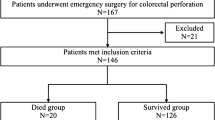Abstract
The purpose of this study was to evaluate the risk factors influencing the short-term results of gastroduodenal perforation to determine the optimal treatment for reducing mortality. A total of 136 patients were retrospectively reviewed and the prognostic factors were examined. Seven patients died within 30 days, with an overall mortality rate of 5.1%. Mortality was significantly worse in those aged 50 years or more, when the leukocyte count was less than 9,500/mm3, when treatment was delayed more than 12 h after perforation, in cases of preoperative shock and renal failure, and when associated with liver cirrhosis or an immunocompromised state. Tolerance to the time delay was inversely proportional to age, while the deaths in patients aged 65 years or younger were related to serious concurrent diseases. Shock and renal failure occurred most often in elderly patients as a result of delayed surgery, and the leukocyte count was an age-dependent prognostic indicator. Thus, age, the time interval between perforation and treatment, serious concurrent disease, shock, and renal failure were presumed to be the most important prognostic factors. Although definitive operations were performed on low-risk patients with an acceptably low mortality, it remains to be determined whether simpler procedures should be adopted for high-risk patients.
Similar content being viewed by others
References
DeBakey M (1940) Acute perforation in gastroduodenal ulceration: a statistical analysis and review of the literature. Surgery 8:1028–1074
Illingworth CFW, Scott LDW, Jamieson RA (1944) Acute perforated peptic ulcer: frequency and incidence in the West Scotland. Br Med J 2:655–658
Jordan GL Jr, DeBakey ME, Duncan JM Jr (1974) Surgical management of perforated peptic ulcer. Ann Surg 179:628–633
Greco RS, Cahow CE (1974) Alternatives in the management of acute perforated duodenal ulcer. Am J Surg 127:109–114
Sawyers JL, Herrington JL Jr, Mulherin JL Jr, Whitehead WA, Mody B, Marsh J (1975) Acute perforated duodenal ulcer, an evaluation of surgical management. Arch Surg 110:527–530
Courtsofitides T, Himal HS (1976) Perforated gastroduodenal ulcers. Am J Surg 132:575–576
Donovan AJ, Vinson TL, Maulsby GO, Gewin JR (1979) Selective treatment of duodenal ulcer with perforation. Ann Surg 189:627–636
Mattingly SS, Ram MD, Griffen WO Jr (1980) Factors influencing morbidity and mortality in perforated duodenal ulcer. Am Surg 46:61–66
Boey J, Wong J, Ong GB (1982) A prospective study of operative risk factors in perforated duodenal ulcers. Ann Surg 195: 265–269
Svanes C, Salvensen H, Espehaug B, Soreide O, Svanes K (1989) A multifactorial analysis of factors related to lethality after treatment of perforated gastroduodenal ulcer 1935–1985. Ann Surg 209:418–423
Schein M, Saadia R, Decker GAG (1986) Perforated peptic ulcer at the J.G. Strijdom Hospital: a retrospective study of 99 patients. SAMJ 70:21–23
Ball ABS, Thomas PA, Evans SJ (1989) Operative mortality after perforated peptic ulcer. Br J Surg 76:521–522
Irvin TT (1989) Mortality and perforated peptic ulcer: a case for risk stratification in elderly patients. Br J Surg 76:215–218
Coleman JA, Dehnham MJ (1980) Perforation of peptic ulceration in the elderly. Age Ageing 9:257–261
Watkins RM, Dennison AR, Collin J (1984) What has happened to perforated peptic ulcer? Br J Surg 71:774–776
Feliciano DV, Bitondo CG, Burch JM, Mattox KL, Jordan GL Jr, DeBakey ME (1984) Emergency management of perforated peptic ulcers in the elderly patient. Am J Surg 148:764–767
O'Riordain DS, O'Dwyer PJ, O'Higgins NJ (1990) Perforated duodenal ulcer in elderly patients. J R Coll Surg Edinb 35: 93–94
Kirkpatrick JR, Bouwman DL (1980) A logical solution to the perforated ulcer controversy. Surg Gynecol Obstet 150:683–686
Shinagawa N, Muramoto M, Sakurai S, Fukui T, Hori K, Taniguchi M, Mashita K, Mizuno A, Yura J (1991) A bacteriological study of perforated duodenal ulcers. Jpn J Surg 21:17
Crofts TJ, Park KGM, Steele RJC, Chung SSC, Li AKC (1989) A randomized trial of nonoperative treatment for perforated peptic ulcer. N Engl J Med 320:970–973
Schein M, Gecelter G, Freinkel Z (1990) APACHE II in emergency operations for perforated ulcers. Am J Surg 159: 309–313
Jordan PH, Morrow C (1988) Perforated peptic ulcers. Surg Clin North Am 68:315–329
Rabinovici R, Manny J (1991) Perforated duodenal ulcer in the elderly. Eur J Surg 57:121–125
Boey J, Branicki FJ, Alagaratnam TT, Fok PJ, Choi S, Poon A, Wong J (1988) Proximal gastric vagotomy, the preferred operation for perforations in acute duodenal ulcer. Ann Surg 208: 169–174
McGee GS, Sawyers JL (1987) Perforated gastric ulcers. A plea for management by primary gastric resection. Arch Surg 122: 555–561
Boey J, Choi SKY, Alagaratnam TT, Poon A (1987) Risk stratification in perforated duodenal ulcers: A prospective validation of predictive factors. Ann Surg 205:22–26
Author information
Authors and Affiliations
Rights and permissions
About this article
Cite this article
Wakayama, T., Ishizaki, Y., Mitsusada, M. et al. Risk factors influencing the short-term results of gastroduodenal perforation. Surg Today 24, 681–687 (1994). https://doi.org/10.1007/BF01636772
Received:
Accepted:
Issue Date:
DOI: https://doi.org/10.1007/BF01636772



